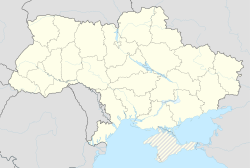Sasiv
|
Sasiv Сасів |
||
|---|---|---|
| Town | ||

Church of the Nativity of St. John the Baptist in Sasiv built in 1864 in the style of Gothic Revival architecture
|
||
|
||
| Location in the Ukraine | ||
| Coordinates: 49°52′15″N 24°56′56″E / 49.87083°N 24.94889°ECoordinates: 49°52′15″N 24°56′56″E / 49.87083°N 24.94889°E | ||
| Country |
|
|
| Region | Lviv Oblast | |
| District | Zolochiv Raion | |
| Town founded | 1615 | |
| Founded by | Jan Daniłowicz | |
| Government | ||
| • Mayor | Гетьманчик Михайло Антонович | |
| Area | ||
| • Total | 1.853 km2 (0.715 sq mi) | |
| Elevation | 272 m (892 ft) | |
| Population (2013) | ||
| • Total | 761 | |
| • Density | 410/km2 (1,100/sq mi) | |
| Time zone | EET (UTC+2) | |
| • Summer (DST) | EEST (UTC+3) | |
| Area code(s) | +380 3265 | |
Sasiv (Ukrainian: Сасів/Sasiv, Polish: Sasów also Sassów,Ruthenian/Ruś.: Sassíw, Russian: Сасов/Sasov) is a town in Lviv Oblast, Ukraine, since 1945. Until 1772 the town was located in the historical territory of Ruthenia, in the Ruthenian Voivodeship of the Crown of the Kingdom of Poland, thereafter until 1919 became part of the Austro-Hungarian Cisleithanian crown lands in the Kingdom of Galicia and Lodomeria (Galicia). From 1919 until 1945 the town was once again part of Poland within the Tarnopol Voivodeship. The town is located 8 km north-east of Zolochiv on the west bank of Western Bug River.
The town's original Polish name Sasów also written as Sassów is derived from the Jan Daniłowicz family coat of arms "Sas" (Saxon) clan, itself derived from the medieval 12th-century German migrants of Saxony, see Transylvanian Saxons. In Ruthenian (Ruś) language the town name was Sassíw.
In 1511, the rural settlement of Komarów (Ukrainian Комарiв) became the property of Anna Sienieńska and was a key part of the commune of Olesko, located in the historical state of Ruthenia, Kingdom of Galicia–Volhynia. In 1605, Olesko and Olesko Castle became the property of wealthy landowner and nobleman Jan Daniłowicz herbu Sas, Voivode of the Ruthenian Voivodeship and grandfather of later King Jan III Sobieski.
...
Wikipedia


